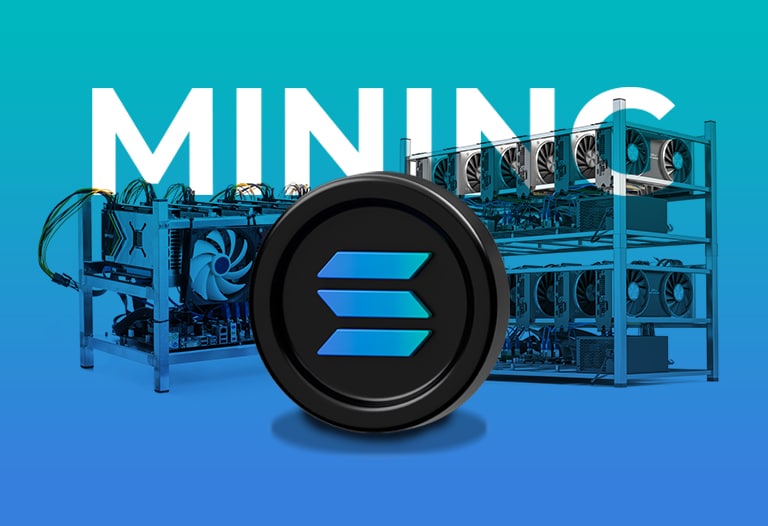
Table of Contents
ToggleIf you still do not know the answer to the question that gives rise to this article, let’s quickly put an end to false expectations and nip the confusion in the bud. Minar Solana is not possible.
We have analyzed, at length, in this blog the differences between blockchains whose consensus is reached through the Proof of Work system versus those that do it through Proof of Stake. Only the networks belonging to the first group have “minable” native coins.
As you can imagine, the Solana network does not belong to that group of networks and therefore its SOL native currency cannot be mined. Anyway, there are means by which we can earn SOL by participating in a process analogous to coin mining, in this blockchain.
Without further ado, let’s get to know it.
Why is it not possible to mine Solana (SOL)?
The answer is simple: the only networks that offer the possibility of mining cryptocurrencies are those governed by the Proof of Work consensus. In these networks, miners offer their computational power to decipher a complex mathematical problem in order to mine the next block in the network. Once this block has been created, the first transaction included in it is a submission by the miner to himself, in which he sends the corresponding amount of coins for his task. This is how new coins are mined or created.
In the case of the Solana blockchain, the method for creating new blocks differs from that used by networks such as Bitcoin or Ethereum, prior to the merge, since its creators have opted for a Proof of Stake model. In it, there are no miners, we find validators and a new player, non-existent in PoW networks, the delegator. Let’s see how these network participants interact in Solana.
First, as in any network, users perform transactions. These are sent to the network nodes, which are in charge of validating them. Once the transactions are validated, they are sent to the validators so that they can create a new block. For this task, they will receive a certain amount of SOL and this is how new units of the currency are created.
Ok, but if these validators do not offer a proof of work that implies an energy expenditure, what do they commit or put at stake to fulfill their role? Let’s look at it below.
Stake within the PoS consensus
A simple but powerful concept, which we know as guarantee or also called “stake”, is what is at stake in this consensus. This guarantee is nothing more than a certain amount of SOL. In case of misbehavior, the validator may be penalized by losing part of his stake.
It remains for us to define the role of the delegators. These can be categorized as ordinary users, those who do not have the time or the physical and financial resources necessary to set up a network validator. In order to participate in the block creation process and obtain rewards, they have the option of choosing a validator of their liking, delegating their SOL to him/her and obtaining a percentage of the profits obtained by this network server when fulfilling his/her vital task.

How can I become a Solana network validator?
Perhaps the most fascinating feature of the crypto world is the concept of “permissionless”. This means that to interact with a blockchain, from wherever we choose, we don’t need to fill out forms, submit credit histories, resumes or anything like that. Basically, we don’t need anyone’s permission.
So, to become validators of the Solana network, from the point of view of hardware components we are going to need:
- 128 GB RAM, as a minimum
- 1TB or more of storage, on an NvME SSD drive
- A modern GPU (graphics card) can give us a certain advantage
- The internet connection must be 1 GB per second.
After meeting the requirements described above, it will also be necessary to download the program needed to create blocks on the network and start the validator. However, the task will not be that simple. It is worth noting that you will need a solid knowledge of Linux, access to a server and the famous “stake”, which today amounts to 50,000 SOL units.
As we have seen, it is not easy to be a network validator. But fortunately, there is a simpler and more affordable way to earn a return of approximately 8% per year, thanks to the SOL delegation.
Let’s take a look at what this option is all about.
How to participate as a delegate in the Solana blockchain?
Becoming a Solana network delegate is an extremely simple task. The first steps, although they may seem obvious, are:
- Create a wallet on the Solana network
- Send SOL to the wallet you have created
Different wallets that provide services on the blockchain, such as Phantom, will directly give us this option. It will be as simple as entering the option “Start earning SOL”, which also shows us the legend “Stake tokens and receive rewards”.
Phantom is extremely direct with the indications it gives us and we do not have too much margin for error. Once we have pressed this option, we will find a list of validators available on the network.
What to consider when choosing a validator in Solana?
Obviously, beyond being extremely simple, the fact of delegating our tokens should allow us to be at ease with that decision. In this regard, before choosing a validator, we should take note:
- Number of tokens delegated
- Percentage commission charged by the validator
- “Uptime, or uptime, during the last period
Although the popularity of the validator or the economic aspect, reflected in the commission it will charge us, are details to be taken into account, from my point of view it is the “uptime” that is the most important.
Of course, no one is exempt from errors or external problems that may prevent the normal operation of a validator 24 hours a day, 7 days a week. In any case, a validator with an uptime below 100% is subject to penalties. The detail to know, is that the penalties applied to a validator replicate on the delegated amounts it has received.
It may be a simple task to delegate, but the necessary investigation that precedes it deserves to be given paramount importance.

Conclusion
The kind of confusions that give rise to titles like the one in this article should be seen as an opportunity to continue along this long, but pleasant, path of education that we have set as our goal. It is important to take the time to explain that it is not possible to mine Solana and to detail the reasons why.
Undoubtedly, the crypto ecosystem beyond the great advances, which should be celebrated, needs to continue to grow. Rooting out this type of confusion is a step in that direction.
Knowledge is the most powerful tool to give rise to free human beings. Just as philosophy liberates our minds, crypto education is capable of liberating our economies. Decentralization must be approached from every possible angle. Let us decentralize knowledge as a means to awaken us to a more just world.




